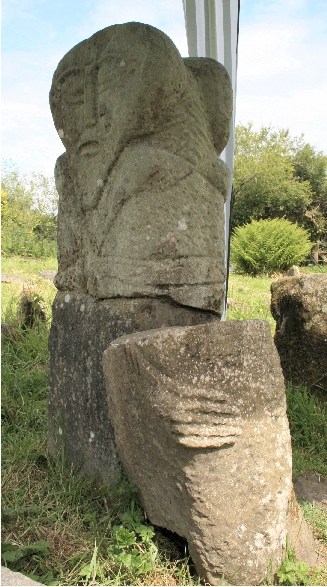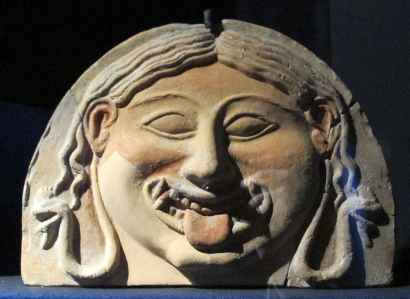Gorgons Were the Nummo
Updated June 2023
 c.400-800 Celtic Idol, Boa IslandShannon Dorey, The Nummo, p. 117 |
This two-sided Celtic idol is found in Caldragh Cemetery on Boa Island in Northern Ireland. One side of this Celtic idol is male with a pointed penis beneath stylised crossed arms, and the other side is female with a protruding tongue. The protruding tongue is a symbol of divinity and associated with the Greek Gorgons.
 Nummo Twins, Musée de Bamako, MaliShannon Dorey, Day of the Fish p. 133 |
My research connects this Celtic idol with Dogon carvings of the Nummo twins with one side male and the other side female.Shannon Dorey, The Nummo, p. 117 Although the Dogon elder Ogotemmêli described the Nummo as having fish tails and being associated with serpents because of the way they moved on land, they were also hermaphrodites or "twins".Shannon Dorey, The Master (Mistress) of Speech, p. 13
Lithuanian-American archeologist Marija Gimbutas associated the Gorgon with the snake goddess further connecting this Boa Island idol with descriptions of the Nummo, who had both fish and snake like characteristics. According to Gimbutas, the Gorgon extends back to at least 6000 BCE.Shannon Dorey, Day of the Fish, p. 24
Archaeologists unearthed Gorgon masks from the Varna cemetery in eastern Bulgaria on the Black Sea coast. The masks' round eyes, long mouth, and studs representing teeth are characteristic of the snake, and Gimbutas associated them with the snake goddess. Other depictions of Gorgons show them with whiskers and fangs.
These descriptions of the Gorgon with their combination of snake-like bodies and whiskers or fangs further describe the Nummo. The Dogon particularly associated the Nummo with the silurus, which is a type of catfish. Most of these fish have barbs, or whiskers, on the jaw. As shown in some Dogon drawings, the Nummo also had these same whiskers.Shannon Dorey, Day of the Fish, p. 24
 Barbed Gorgon With Dual SerpentsBy Sailko - Own work, CC BY 3.0, https://commons.wikimedia.org/ w/index.php?curid=31977145 Antefissa semiellittica con gorgone, 510-500 ac ca., da taranto (MAN taranto).JPG |
This is an antefix of a Gorgon dated 510-500 BCE from Taranto, Italy. The significance of this piece, aside from the whiskers, are the dual serpents. Because the Nummo were hermaphrodites or "twins" they were associated with dual serpents. My research reveals that Gorgons, who were later demonized by the patriarchal Greeks, were representations of the Nummo. During his research on Greek mythology, Karl Kerényi associated the Gorgon with a sea goddess. The Nummo, who were primarliy aquatic beings, were identified with the sacred feminine.Shannon Dorey, Day of the Fish, p. 28
Kerényi discovered that parents used to name their little girls "Gorgo" after the Gorgon. He reported that "One cannot believe that 'Gorgo' meant only something ugly and terrible; for the same name used to be given to little girls, whose parents certainly did not expect them to turn into terrifying creatures!"
This would suggest that in the early years the Gorgon was so respected that parents actually named their daughters after her. Over time ancient Greece became a patriarchal culture and with it the reversal of the religious symbols of the Goddess. It was at that time that the warring tribesmen likely turned the female Gorgon into a figure of evil.Shannon Dorey, Day of the Fish, p. 78
The androgynous twin aspect of the Nummo appears on many other ancient artifacts in places including Mexico, Greece, China, Peru, Iraq and Italy.Shannon Dorey, Day of the Fish Chapter 24, Twins and Cowries pp. 137-154 For more on this refer to my article on the Nummo Twins in World Cultures.
For more information on the Dogon religion refer to my books, The Master (Mistress) of Speech, The Nummo, Day of the Fish and The Rose.